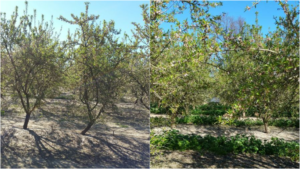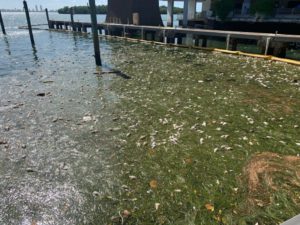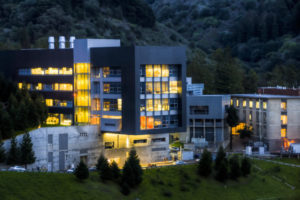Plant Nutrition Technologies, Inc: Commercializing Remineralization while Protecting Waterways

Dennis Amoroso, President of Plant Nutrition Technologies, Inc. posing with his remineralized rose bushes at his California home.
It’s tough to teach an old dog a new trick, and the agricultural industry has relied on NPK fertilizers for almost 100 years with essentially no alternatives for large farms. That is to say that for a century, conventional fertilizers have been the only proven “trick” that could produce enough food for our swelling population, and so the consideration of other fertilizers has gained little ground within the large-scale agriculture industry. But as pollution and runoff from artificial fertilizers pose greater threats to human and environmental health, markets are increasingly looking for sustainable alternatives that can eliminate the waste pouring out of our farms and into our waterways. Dennis Amoroso of the California-based Plant Nutrition Technologies, Inc. (PNTI) is confident that his group has developed one such alternative: A revolutionary all-natural fertilizer that can breed healthy microbes, restore soils, store carbon, and drastically improve profitability for farmers.
Because of their efforts, remineralization is more feasible now than it ever has been. PNTI’s strategy to develop the product, support the technology to prove its capability, and partner with influential stakeholders ensures that rock-dust based fertilizers will have strong demand in the market for years to come.
Unlike conventional fertilizers, which focus solely on directly supplying NPK nutrients to plants, products from PNTI also prioritize the health of the soil itself to create an on-going, long lasting agricultural cycle. Crucial to maintaining growth over multiple seasons is the cultivation of microbial communities within the soil. Microbes and plants are in a constant state of symbiosis, using one another to react with the soil and cultivate the nutrients needed to grow and reproduce. When microbial communities are ignored, their absence results in poor soil that is unable to grow healthy, nutrient-dense foods. Because traditional fertilizers typically only supply nitrogen, phosphorus and potassium, they do not contain many vital micronutrients, and thus farm productivity suffers. The all-natural fertilizers from PNTI contain rock dust, mine tailings, wood ash, compost, biochar, and other ingredients to foster microbes that will be productive for years into the future, modeling the composition of their products based on characteristics of older forests. Many of these ingredients are sourced from companies who would have otherwise thrown them away: gravel dust and ore tailings are a common byproduct of mining operations, and the compost is largely made of waste from food manufacturing companies. One trial demonstrated that almond crops fertilized with PNTI’s mixture yielded 75% more fruit than the previous year’s artificially-fertilized harvest.
I had the chance to speak with Amoroso about Plant Nutrition Technologies’ products, and his efforts to get them into commercial soils. “We’re not out of our bloody minds,” he told me. “You tell a farmer you can grow something without chemical fertilizer, he’ll tell you you’re nuts! But when they see the data, they say ‘Hey, that’s not such a crazy idea after all.’” But in addition to the benefits for food production, a conversion from conventional fertilizers to all-natural forms like those from PNTI would mean an end to the negative environmental externalities associated with NPK fertilizers, the main one being the pollution of our waterways via run-off.
Pollution run-off occurs when rain, snowmelt, or irrigation systems flood lands that have been fertilized with artificial products. In modern agriculture, NPK fertilizers are frequently applied in higher concentrations than can be absorbed in the soil, causing the remaining nitrogen and phosphorus to be carried away via water flows. There are a variety of problems associated with this process, and the sheer number of people who have been or could be affected by this is shocking. From an anthropocentric standpoint, many health problems have been linked to this run-off. Blue baby syndrome is one such problem, an illness where excessive concentrations of nitrate are consumed by nursing mothers and passed along to their infants. The increased nitrate affects the ability of their blood to absorb oxygen molecules, and can cause difficulty breathing, lethargy, and sometimes death. High levels of nitrates have also been linked to increased cases of fatal diseases like Alzheimer’s and Parkinson’s. Suzanne de la Monte, a leading researcher on the project, said, “Not only do we consume (nitrates) in processed foods, but they get into our food supply by leaching from the soil and contaminating water supplies… potential solutions include eliminating the use of nitrites and nitrates in food processing, preservation and agriculture.”
Ecologically speaking, one of the most well-known and problematic effects of run-off is eutrophication in our freshwater and coastal ecosystems. Excess nitrogen tends to encourage an overproduction of algae, whose population absorbs most of the oxygen in the water and chokes species to death in a vicious cycle called hypoxia. The water becomes uninhabitable, and causes a domino effect that can wipe out a majority of the aquatic biodiversity in these environments. As reported by the New York Times, one such “dead zone” in the Gulf of Mexico was measured at 7,000 square miles in 2019. Commercial fisheries suffer in turn: according to a study published in Nature, “The estimated cost of damage mediated by eutrophication in the U.S. alone is approximately 2.2 billion dollars annually.”
On the Pacific Coast, those in California and Oregon have witnessed spontaneous hypoxic events that threaten their livelihoods. According to Francis Chan, co-chair of the California Hypoxia Science Task Force, “We can now say that Oregon has a hypoxia season much like the wildfire season.” In an interview with NPR, Crabber David Bailey, based in Oregon, confirms this: “It shows up like a flip of a switch… If there are crabs in the pot, they’re dead… when you go out the next time, they’re blanks, they’re absolutely empty. The crabs have left the area.” This is exactly the kind of detriment that has inspired Dennis Amoroso and others to produce sustainable alternatives that can protect our waters. “I don’t care how we get it in the field, I’m tired of the chemical companies killing our state. I’m just tired of it. Whatever we can do to get chemical fertilizers out of agriculture, we’re going to do it, and we are the replacement.”
Not only would a replacement of artificial products alleviate the above environmental and human health problems, it would also make production more affordable for farmers. As I mentioned before, the diverse spread of micronutrients found within PNTI fertilizers can grow larger, more nutritious foods than those grown conventionally, so that farmers would have more profits to put towards their bottom line. But in addition to more food, plans from states and the federal government to prioritize carbon sequestration can add a new revenue stream for farms in the form of carbon storage credits. These credits work differently depending on various factors like the state and type of technology, but they essentially pay firms for storing carbon. They’re becoming a hot commodity for polluters given the increasing mandates geared towards decreasing emissions, and commercial farms would be able to generate a lot of them. Farms who purchased rock-dust based fertilizers could seize the benefits of these credits via tax deductions or direct payments, and could also choose to sell them to other firms looking to lower their CO2 output.
Right now Amoroso and PNTI are in the midst of partnering with the North Dakota Farmers Union, who aims to capitalize on these types of credits while improving their environmental footprint by securing a long-term contract for their fertilizer supply. They represent about 2.2 million acres of farmland, and the storage potential from such a partnership would be immense. PNTI is also collaborating with Lawrence Berkeley National Labs to develop a state-of-the-art carbon mapping technology that can visualize real soil carbon data. Being able to quantify how much carbon is stored will be crucial for earning carbon storage credits, as well as further proving the efficacy of their product.
Because of their efforts, remineralization is more feasible now than it ever has been. PNTI’s strategy to develop the product, support the technology to prove its capability, and partner with influential stakeholders ensures that rock-dust based fertilizers will have strong demand in the market for years to come. In the face of inevitable legislation mandating cleaner agriculture, they have cemented their product as a legitimate replacement for costly artificial fertilizers, and have proven that all-natural fertilizers really can be mutually beneficial for both the economy and environment.
Our mission at Remineralize the Earth has always been to advocate for rock dust with the hope that one day it will be the clear cut answer for sustainable agriculture, and Plant Nutrition Technologies, Inc. is bringing that hope to fruition. In the eyes of Dennis Amoroso, the only thing standing in their way now is education of the public. Of the skepticism from farmers towards alternative and sustainable methods, Amoroso said “That is dissolving away, especially since the signing of Biden’s executive order. So far it’s seemingly made people more open, willing, and wanting of products like ours.” When I asked Amoroso what he most wished the public and industry understood about the implementation of all-natural rock dust fertilizers, he had this to say:
“I want them to understand that it affects them at a very personal level. When we supply these nutrient-rich products to the farmers, the product grows more nutrient-dense food. We’ve lost 80 percent of the nutrients in our foods over the last 60 years. Now they get nutrient dense food, their children are eating it, pregnant mothers are eating it, and the cost of healthcare goes through the floor. It affects them all at a very personal level…When you think about the fact that residents in California need nitrogen filters on their water supply, to me it’s just stupid. I’ve raised three boys, and they are not excited about the potential of a world where the water is dirty, air is unhealthy, and the oceans are higher, and neither are we. Our product is here, and we’re ready to go.”
Support us on Patreon
Thank you for joining us today! Please become a member of RTE and support us on Patreon. Unlike many larger organizations, we work with a team of determined and passionate volunteers to get our message out. We aim to continue to increase the awareness of remineralization to initiate projects across the globe that remineralize soils, grow nutrient dense food, regenerate our forests’ and stabilize the climate – with your help! If you can, please support us on a monthly basis from just $2, rest assured that you are making a big impact every single month in support of our mission. Thank you!












Olivia B
May 20, 2021 (8:42 pm)
Incredibly insightful examination of a groundbreaking technology.